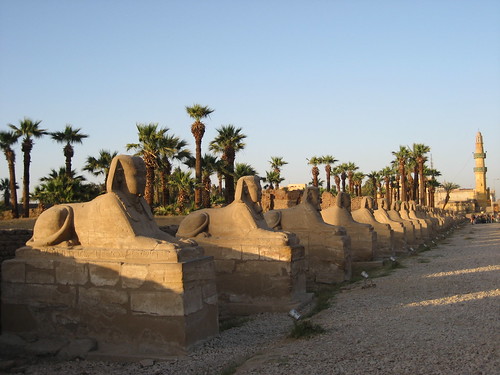 Egypts Minister of Culture, Farouk Hosni, and Zahi Hawass, Secretary General of the Supreme Council of Antiquities (SCA), along with the governor of Luxor, Samir Farag, will embark today on an inspection tour along the Avenue of Sphinxes that connects the Luxor and Karnak temples. During this visit, they will install the piece of red granite that was returned to Egypt by the Metropolitan Museum of Art in its original place at the Ptah temple at Karnak.
Egypts Minister of Culture, Farouk Hosni, and Zahi Hawass, Secretary General of the Supreme Council of Antiquities (SCA), along with the governor of Luxor, Samir Farag, will embark today on an inspection tour along the Avenue of Sphinxes that connects the Luxor and Karnak temples. During this visit, they will install the piece of red granite that was returned to Egypt by the Metropolitan Museum of Art in its original place at the Ptah temple at Karnak.
Built by the 30th Dynasty king Nectanebo I (380-362 BC), the avenue is 2,700 meters long and 76 meters wide, and lined with a number of statues in the shape of sphinxes. Queen Hatshepsut recorded on her red chapel in Karnak temple (explore the evolution of this temple in Digitial Karnak) that she built six chapels dedicated to the god Amun-Re on the route of this avenue during her reign, emphasising that it was long a place of religious significance.
The Avenue of Sphinxes is one of the most important archaeological and religious paths in Luxor, as it was the location of important religious ceremonies in ancient times, most notably the Beautiful Feast of Opet.
The Opet Festival was celebrated annually in Thebes, during the New Kingdom period and later. The statues of the gods of the Theban Triad – Amun, Khonsu and Mut – were escorted, hidden from sight in a sacred barque, in a joyous procession down the Avenue of Sphinxes from the temple of Amun in Karnak, to the temple of Luxor in order to relive their marriage.
Dr. Hawass said that developing the Avenue of Sphinxes is part of the SCAs collaboration with the Luxor government – one of the issues is to tackle air pollution damaging the monuments – to develop the whole city into an open-air museum. The SCA allocated an amount of LE 30 million to remove all encroachments and compensate those who own houses and shops along the route, as well as another LE 30 million for excavation and restoration works. These works are carried out in three phases; the first was to build a low wall alongside the avenue in order to preserve it from any further encroachment, the second phase is the excavation and the final step is the restoration of the area.
 The excavation team unearthed a large number of fragmented sphinxes that are now undergoing restoration efforts led by SCA consultant Dr. Mahmoud Mabrouk in order to be placed on the site.
The excavation team unearthed a large number of fragmented sphinxes that are now undergoing restoration efforts led by SCA consultant Dr. Mahmoud Mabrouk in order to be placed on the site.
Along the avenue there were originally 1350 sphinxes. Many of the stone guardians were removed and reused during the Roman period and the Middle Ages.
Each of the excavation sections is revealing more sphinxes as well as the cartouches of several kings and queens.
One of the reliefs bears the cartouche of Queen Cleopatra VII. Dr. Hawass believes that this queen likely visited this avenue during her Nile trip with Mark Anthony and implemented restoration work that was marked with her cartouche.
Remains of Queen Hatshepsuts chapels, which were reused by king Nectanebo I in the construction of sphinxes, have been found as well, along with a collection of Roman buildings – remains of wine factories and a huge cistern for water.
Examples of other restoration and protection works currently ongoing in Egypt are the make-over for the Giza area – including the construction of the Grand Egyptian Museum and drilling under the Sphinx to keep its paws dry – as well as preventing Saqqara’s Step Pyramid from collapsing. The Getty Institue is getting it very busy cleaning King Tut’s tomb (just what are those weird brown spots?!), but in the end, we tourists might even end up with an entire Replica Valley of the Kings to visit. What about things (a tiny bit) less ancient? Watch the video about the restoration of one of the oldest Coptic Monasteries still existing, Deir Mar Antonios.